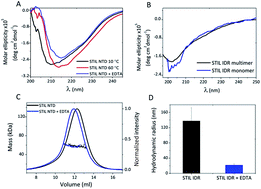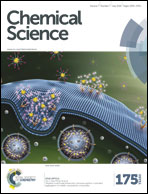Differential effects of zinc binding on structured and disordered regions in the multidomain STIL protein†
Abstract
Binding of metal ions is an important regulatory mechanism in proteins. Specifically, Zn2+ binding to disordered regions commonly induces a disorder to order transition and gain of structure or oligomerization. Here we show that simultaneous binding of Zn2+ ions has different effects on structured and disordered domains in the same multidomain protein. The centrosomal STIL protein bound Zn2+ ions via both its structured N-terminal domain (NTD) and disordered central region (IDR). Zn2+ binding induced structural rearrangement of the structured NTD but promoted oligomerization of the IDR. We suggest that by binding Zn2+ STIL acquires a different conformation, which allows its oligomerization and induces its activity. Sequence alignment of the oligomerization region revealed a new suggested motif, SxKxS/SxHxS/SxLxS, which may participate in STIL oligomerization. Binding of the same metal ion through a disordered and a structured domain in the same protein is a property that may have implications in regulating the protein activity. By doing so, the protein achieves two parallel outcomes: structural changes and oligomerization that can take place together. Our results describe a new important role of the delicate interplay between structure and intrinsic disorder in proteins.


 Please wait while we load your content...
Please wait while we load your content...